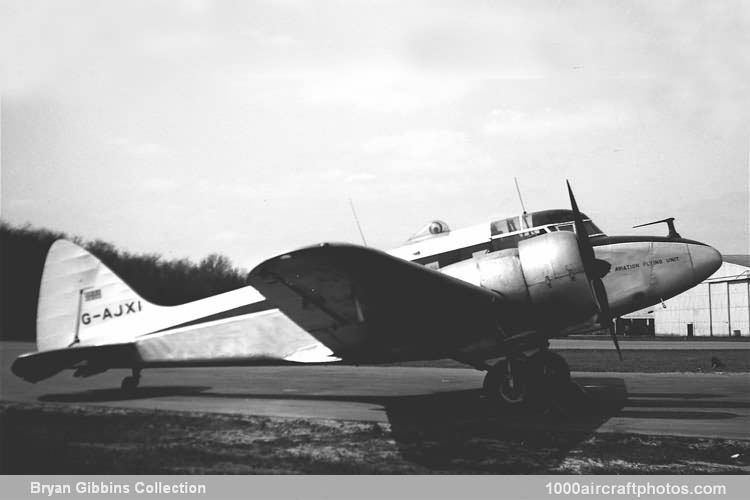06/30/2011. Remarks by Johan Visschedijk: "In the years 1946 to 1948 the Airspeed factory at Portsmouth, England converted over 150 surplus Oxford airframes into light civil transports designated the AS. 65 Consul. During the immediate post-war years these gave sterling service and satisfied the demand for charter-class aircraft at a time when more modern designs were not yet available. All the main Oxford components were retained, but the cabin was redesigned to accommodate six passengers.
Double doors were fitted to the cockpit bulkhead, extra windows installed and luggage space provided at the rear of the cabin. The prototype G-AGVY, converted from the de Havilland built Oxford with s/n V3679, received its CofA on March 15, 1946, and in the standard dark blue and gold Consul color scheme was delivered to the Bata Shoe Co. Ltd. for communications between its European factories.
All subsequent Consuls carried passengers' baggage in an elongated nose which not only released cabin space and extended the C.G. range, but also provided a valuable recognition feature. Airwork Ltd. were appointed official distributors, their demonstration machine G-AHEG, formerly Oxford with s/n T1206, being delivered to Heston in April 1946. The type suited the embryo post-war charter industry very well, and during the following 12 months 70 were delivered to British firms alone.
Their rugged serviceability was used to good advantage on short haul work and on long-distance charters which took them to all parts of Europe, the Near and Middle East and to Central and South Africa. The type was also in considerable demand in the Near East, French Indo-China, Burma and Central Africa, a demand which largely contributed to its eventual disappearance from British skies.
A number were leased by Mortons, Chartair, International Airways and Air Enterprises in 1947 to 1949 to the United Nations Commission in Israel. They were painted white and bore the large letters UN and a numeral in the 90-110 range. While engaged on this work, the prototype was lost in a crash in a remote part of Lebanon on February 11, 1949.
One of the last home orders was for five special models G-AJXE to G-AJXI delivered to the M.C.A. Flying Unit at the end of 1947 for use in training and testing commercial pilots in instrument-flying and blind-approach techniques and also for calibrating airport radio installations. Two others, G-AIUX 'Star Master' and G-ALTZ, 'Star Monitor', were used for a similar purpose by BOAC, both inherited from the old British South American Airways Corporation.
Consul variants have been few, a prototype ambulance version, G-AJWR, with enlarged door, was exhibited at the 1947 Radlett SBAC Show, but, like many others, was exported immediately to French Indo-China. Two standard Consuls G-AIEA and the pictured G-AJXI were refitted with Oxford noses and went to French West Africa as F-OAHJ and F-BHVY respectively for aerial survey work.
Following the original flight testing of the Alvis Leonides engine in an Oxford, Consul G-AKCW, formerly Oxford NJ318, was acquired by the Ministry of Supply and renumbered VXS87. It was then handed over to Alvis Ltd. at Baginton for further work in this direction."
